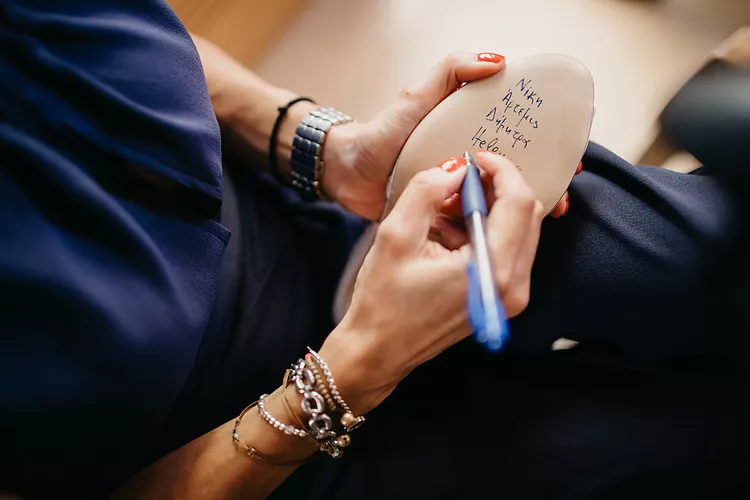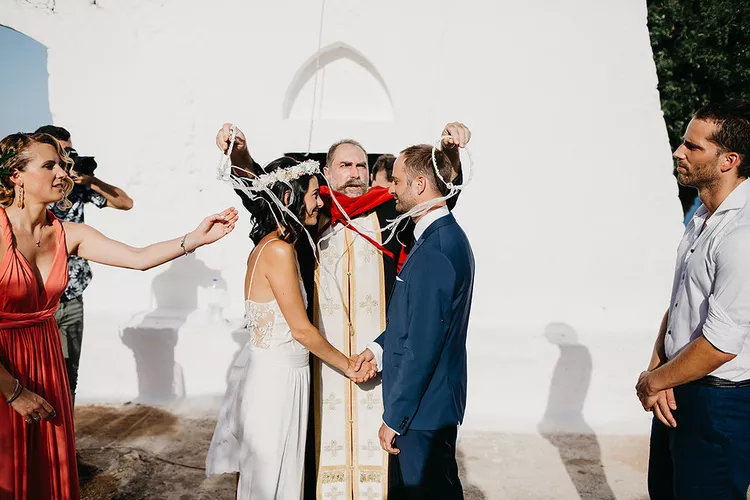Greek Wedding Rituals & Traditions
Greek Wedding Rituals & Traditions
Greek Wedding Traditions
As one of Sydney's leading marriage celebrants, I custom create each ceremony to include those aspects that are important to you. Below I have listed some Greek wedding traditions which we can include all aspects or a few of your family backgrounds and traditions.
Ceremonial ElementsThe bride can place a lump of sugar – for a sweet life – inside her glove. Or she can walk down the aisle with a gold coin in her shoe to bring prosperity. The groom can put a piece of iron in his pocket to ward off evil spirits.
Also, odd numbers are considered luckier than even numbers. The bride and groom should have an odd number of attendants. You spit an odd number of times. An odd number cannot be divided – which is what we hope too for the couple
The ceremony will traditionally follow the ceremonies and rituals of the Greek Orthodox Church. Specific elements include the crowns, the candles, and the common cup. The ceremony has many steps and can easily last an hour – if not longer!
The groom waits for the bride at the front of the church. He holds her bouquet, waiting for her. She is walked down the aisle by her father, presented to the groom, and handed the bouquet.
Two gold crowns are made and connected by a single strand of ribbon. This symbolizes the union of the two people into a single married couple. The crown also signifies that they shall rule over their household together. The crowns are called “stefana” in Greek. During the ceremony, the crowns are swapped back and forth three times by the koumbaro.
The bride and groom also hold candles during the ceremony. These symbolise the light that Christ symbolises The candles can be left in the church to burn, or brought back home to be used, but should never be thrown out. They should be burned down completely.
The priest will pour wine into the “common cup” – that is, one single wine glass – and the bride and groom each take three sips from it. The wine symbolizes life, and the sharing of sips of it is symbolic of how the couple will share in life together.
There are also other practices that are unique to the Greek Orthodox ceremony. The koumbaro will also exchange the wedding rings three times between the couple before they are blessed and placed on the couple’s right hands. The couple will hold their right hands together during the ceremony to highlight their new life together as one unit. Then lastly, as they wear the crowns, the couple walks around the table that holds the cup, the Bible, and the candles. They are lead by the priest in this first walk together as husband and wife. This walk is a symbol of their commitment to stay with each other throughout life’s journey. The priest blesses the couple and removes the crowns. No vows are uttered by the couple – their union is cemented by the blessings of the priest and the witnessing of the congregation
Beautiful Greek Music ~ Bouzouki Music for Weddings
Engagement Rings
When Greek couples get engaged, they typically exchange engagement rings in the presence of their family. A party follows! Each partner gets a plain gold band to wear on the left hand to signal the engagement. (A big diamond solitaire for the woman only is not the Greek custom.)
These are the same rings that the couple will wear as their wedding rings. The bands are blessed during the wedding ceremony, and then the couple switches them to the right hand.
Greek Dancing
At more traditional weddings, the Greek band will play songs and exuberant group dances wind their way around the reception space. Most receptions are a mixture of styles and generations paying homage to their Greek roots and traditions while also celebrating in a modern way. In smaller Greek villages, there is an old tradition of pinning money to the bride’s dress at the reception during a special dance. In America, this tradition is more of a “showering” of a gift. When the couple dances near, the guests will toss a whole wad of bills at them. It's optional for guests to participate, but bring a few dollar bills if you want to join in the festivities. The money symbolizes helping the couple get established.
Bride's Wedding Shoes
PHOTO BY Liron Erel & Co.
In some areas of Greece, the groom gives the bride her wedding shoes as a gift. The Koumbaro delivers them to her while she is getting ready, and then a whole charade plays out as the bride insists that they are too big. The Koumbaro fills the shoes with money to make them fit her until she is satisfied. Finally, all of the unmarried bridesmaids write their names on the soles of the shoes. At the end of the wedding day, the names worn off the shoes are going to be married soon.


The Crowning of Stefana
The Crowning of Stefana
The highlight of the sacrament is called “The Crowning." A single ribbon attaches two crowns, called Stefana, together. When the priest places them on the groom and bride's heads, they are crowned by God as king and queen of their home and founders of a new generation. The crowns are exchanged on their heads three times by the Koumbaro or Koumbara.
Blessing of The Rings
During the ceremony: Blessing the rings.
Continuing the tradition of three, at the start of the ceremony, the couple places the rings on the tips of their wedding fingers, and the Koumbaro will exchange them three times. The priest will then bless them three times.
Greek wedding couple at the ring exchange of the ceremony
Did you know the best day to set your Wedding date is:
Wedding date
Setting the wedding date in the Greek culture is never overlooked. Even if you are planning a Greek orthodox church wedding, you must follow the culture. There are certain times of the year when Greek weddings cannot take place at all.
These periods include
Great Lent, the two weeks before the Dormition of the Theotokos on August 15
The elevation of the Holy Cross on September 14
The 40 days leading up to Christmas
January is the best month to marry since it is the month dedicated to Hera, the goddess of marriage and fertility.
Preparing The Bride
Preparing The Bride
The bride is similarly prepared by her koumbara – or maid of honor – and dressed by her friends. On the bottom of the bride’s shoes are written the names of all her unmarried friends. The names that get worn away by the end of the night are the names of the women who will be married soon themselves.
The bride, once she is dressed, traditionally leaves with her father. She is told by her mother to look back at her parents’ house one last time to ensure that the children take after that side of the family.
Preparing The Groom
Preparing The Groom
On the day of the ceremony, the groom’s friends will gather to help him get ready. His best man – called the “koumbaro” – will shave the groom. This shows the trust between them. The koumbaro will also stand by the groom during the ceremony, and has other obligations like procuring the wedding crowns.
All the other friends present help to dress the groom. One might button the shirt. Another might put the jacket on him. That way they all have a symbolic role in getting him ready.


